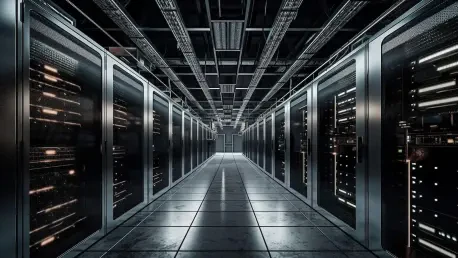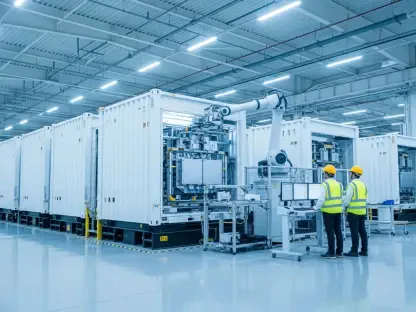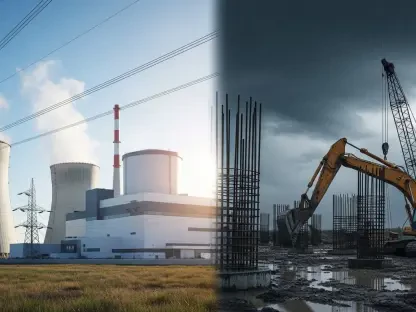Growing demand for data centers is significantly impacting energy generation, fostering unforeseen environmental and economic consequences. Strikingly, as digital infrastructure burgeons, utilities are increasingly relying on fossil fuel-driven power sources. This trend threatens to derail commitments to sustainable energy goals. Such dynamics have created an unexpected tug-of-war between the technological advancement represented by data centers and the pressing need for cleaner energy solutions, prompting concerns about whether these centers are inadvertently bolstering fossil fuel usage rather than supporting the anticipated shift toward renewable energy alternatives.
Rising Influence of Data Centers on Energy Policy
Virginia’s Hyperscale Data Center Phenomenon
Virginia stands as a primary example in this unfolding narrative, with its extensive data center market significantly contributing to energy policy decisions. Hosting over 150 hyperscale data centers, the state exemplifies the broader national issue, whereby data center demand underpins decisions to delay the retirement of coal-powered plants. Dominion Energy’s resource plan serves as a stark illustration, justifying extensions of coal usage due to projected energy needs spurred by data centers. This position undermines mandates like the Virginia Clean Economy Act, intended to transition to renewable energy by 2045, showcasing how perceived energy demands can perpetuate fossil fuel reliance. The strategic decision-making embraced by Dominion highlights the complex challenges utilities face as they balance instantaneous power needs with long-term sustainability objectives.
Broader Implications in the Southeastern United States
This phenomenon is not limited to Virginia, extending into the broader Southeastern United States. Utilities across states such as Georgia, North Carolina, and South Carolina are proposing massive investments in gas power plants, anticipating demands primarily linked to burgeoning data centers. The stark reality is that data centers are projected to command a significant portion of energy load growth, further entrenching fossil fuel dependency. By underpinning utilities’ rationalizations for new fossil fuel projects, these centers inadvertently delay pivotal advances towards cleaner energy solutions, challenging efforts aimed at innovating green technologies and provoking a reevaluation of the energy landscape’s trajectory.
Environmental and Economic Ramifications
Impacts on Marginalized Communities
The escalating demand for data center energy has environmental consequences that disproportionately affect marginalized communities. Many of these communities endure the harsher environmental and health impacts tied to prolonged operation of fossil fuel plants. Notably, numerous facilities previously designated for closure remain operational, constraining environmental progress and exacerbating disparities. The speculative nature of data center energy requests compounds this problem, leading to demand overestimations that distort planning and reinforce reliance on carbon-intensive energy sources. Such tendencies reveal systemic flaws in current approaches, prompting calls for comprehensive reassessments to account for the genuine ecological costs faced by vulnerable populations.
Economic Burden on Ratepayers
Beyond environmental repercussions, the shift towards sustaining older, costly power plants bears a significant economic burden. Utilities frequently pass hefty infrastructure costs onto consumers, inflating ratepayer bills. This financing model obstructs the affordability of utility services, drawing attention to the pressing need for strategic regulatory interventions. In states like West Virginia, for instance, ratepayers must fund transmission projects designed explicitly to service the data center boom, illustrating how broader networks become encumbered by digital infrastructure demands. This trend underscores the requirement for more calculated investments that align financial models with sustainable energy transitions.
Response Strategies and Potential Solutions
Innovative Regulatory Measures
To combat the economic impositions and encourage responsible demand management, states are innovating legally binding measures to curb costs, maximize efficiency, and mitigate impacts on ratepayers. Dominion Energy’s new rate class proposal, requiring intensive energy users to commit to longer-term contracts, exemplifies this approach. Similarly, American Electric Power facilities in Ohio impose tariffs fostering greater accountability for data centers. By aligning demand forecasts more precisely with consumption, such regulatory interventions help deter speculative interconnection requests while providing a pathway for alternative solutions.
Legislative and Utility Initiatives
In response to growing challenges, legislative bodies are introducing initiatives aimed at aligning data center energy use with renewable sources. California’s proposal, advocating tax reductions for operators utilizing predominantly clean energy, represents early steps toward implementing incentives to reshape data center energy consumption patterns. North Carolina’s initiative, facilitating direct investments in solar developments, similarly provides incentive-driven models for utilities, although debates persist over their authenticity and effectiveness. Critics worry such initiatives might merely subsidize existing green developments without fostering substantial change, emphasizing the importance of assertive regulatory frameworks tailored to address future consumption patterns.
Decarbonization Efforts by Tech Companies
Tech giants, holding significant influence due to their heavy energy demands, are initiating independent decarbonization efforts. These endeavors, including Microsoft’s controversial restart of the Three Mile Island nuclear facility, illustrate varied strategies to procure carbon-free power. Yet, these methods evoke paradoxical outcomes, as reliance on sources like nuclear energy can drive other sectors toward fossil fuels. Consequently, utility-depleting power purchases create complexities in broader decarbonization efforts, signifying the intricate balance tech companies must navigate in maintaining business operations while supporting environmental sustainability.
Future Directions and Regulatory Challenges
The increasing demand for data centers is having a notable impact on energy generation, leading to unexpected environmental and economic repercussions. Remarkably, as the digital infrastructure continues to expand, utility companies are progressively relying on power sources driven by fossil fuels. This reliance poses a threat to commitments made toward achieving sustainable energy objectives. Consequently, this trend has sparked a surprising conflict between the technological growth signified by data centers and the urgent need for cleaner energy solutions. Such dynamics have raised concerns over whether these data centers are inadvertently promoting fossil fuel dependency instead of supporting the anticipated move toward renewable energy alternatives. As society grapples with this dilemma, the challenge lies in balancing the growth of digital technology with environmental stewardship, ensuring progress doesn’t come at the cost of sustainable energy goals.









